- What's New?
- Monthly Guide
- Private Israel Day Tours
- Tel Aviv Tours
- Jerusalem Tours
- Jewish Heritage Tours
- Christian Holyland Tours
- Israel Highlights Tour
- North Israel Tours
- South Israel Desert Tours
- Private Israel Wine Tour
- Organized Day Tours
- Jerusalem Day Tours
- Israel Group Tours
- Bethlehem Tours
- What to See and Do
- Just A Day in Tel Aviv
- Unique Neighborhoods
- Tel Aviv Museums
- Tel Aviv Shopping
- Where To Eat
- The Best Restaurants
- What to See in Jerusalem
- Jerusalem's Christian Sites
- Jerusalem's Islamic Sites
- See and Do in Israel
- Israel's 10 Must-Sees
- The Judean Desert
- Masada Desert Fortress
- The Negev Desert
- The Dead Sea
- Wonderful North
- Akko - Acre
- Haifa's Bahai Gardens
- Israel Nature
- Essential Sites
- Judean Hills
- Jerusalem Monasteries
- All Tel Aviv Hotels
- Cheap Hotels
- Airport Hotels
- All Jerusalem Hotels
- Guesthouses
- Boutique Hotels
- Luxury Hotels
- Midrange Hotels
- Travel Tips
- How to get here
- Tel Aviv Tales & Facts
- Facts About Israel
- Fun Israel Facts
- Israel Souvenirs

Abu Ghosh in the Judean Hills Visit Abu Ghosh for scenic views, ancient churches, the New Mosque and great local cuisine
Nestled in the Judean hills just minutes from Jerusalem, Abu Ghosh is a small Arabic town that is well worth visiting.
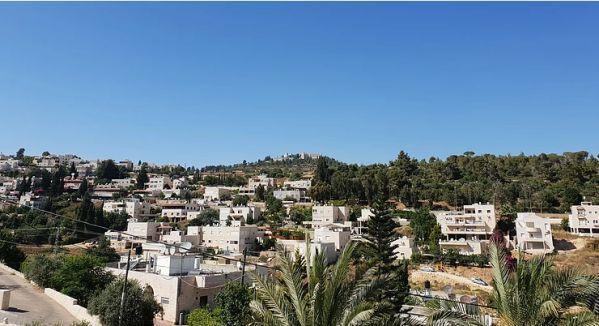
Most Israelis stop by Abu Ghosh mainly for its delicious Middle Eastern cuisine. Read more here.
But Abu Ghosh is much more than a place to eat on the way to Jerusalem!
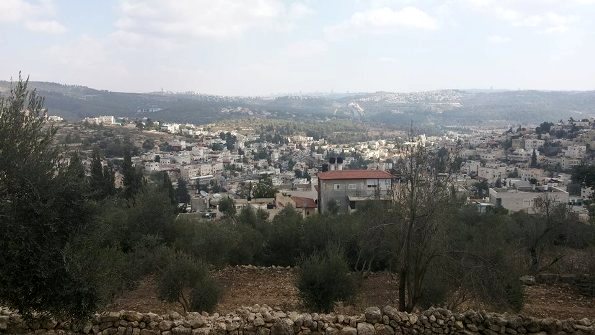
It has beautiful views, Crusaders churches, the second largest mosque in Israel, ancient history and the largest vocal music festival in Israel.
Thousands of vocal music fans flock to Abu Ghosh twice year for a few days to enjoy music concerts and festivities. The concerns take place during Shavuot (Pentecost) and Sukkot (Tabernacles) holidays.
The Fascinating Story of the People of Abu Ghosh
Abu Ghosh has about 7,000 residents. Most are Muslims but there are Christians and even Jews, all living side together peacefully. The village is considered a model of coexistence.
The four local Abu Ghosh clans trace their origins to Chechen and Ingush tribes from the Caucasus Mountain areas. Known for their courage and strength as fighters, they were recruited by the Ottoman Sultan Selim to help conquer the land in the 1500's.
Abu Ghosh people were known for their great pride and wealth. For hundreds of years, the Abu-Gosh tribes controlled the road from Jaffa Port to Jerusalem and imposed a 'traveler's tax' on all pilgrims passing through. They were given this 'privilege' by Sultan Selim's son, Suleiman the Magnificent who built the walls surrounding the old city of Jerusalem.
Today, there is a renewed interest by the people of Abu Ghosh in their Chechen roots.
The New Mosque
In honor of the historic ties between the inhabitants of Abu Ghosh and the Chechen people, President Akhmad Kadyrov of Chechnya funded the building of the second largest mosque in Israel.
Completed in 2014, it is second in size after Al Aksa Mosque in Jerusalem.
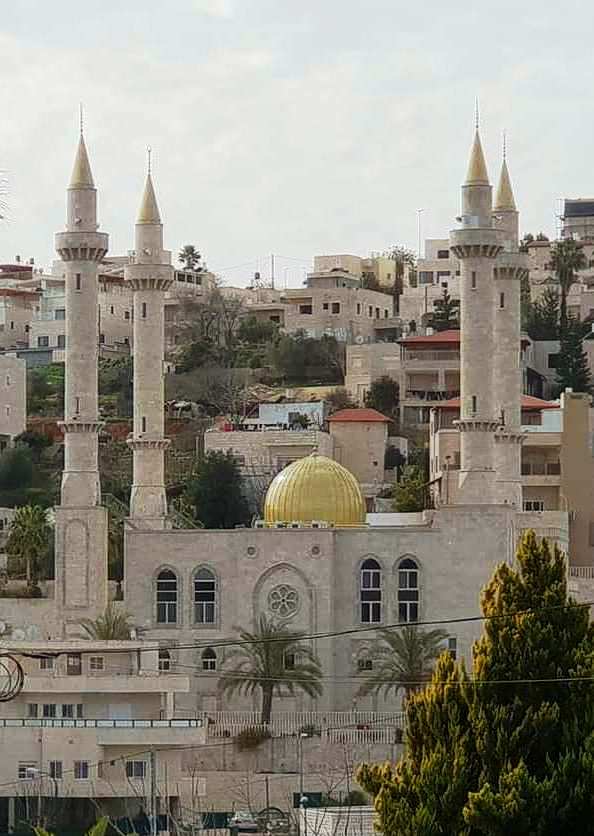
The beautiful mosque catches the eye of anyone traveling on the road from Tel Aviv to Jerusalem, especially at night, with its four tall minarets towers illuminated in green light.
The mosque uniquely combines both local and Caucasus styles.
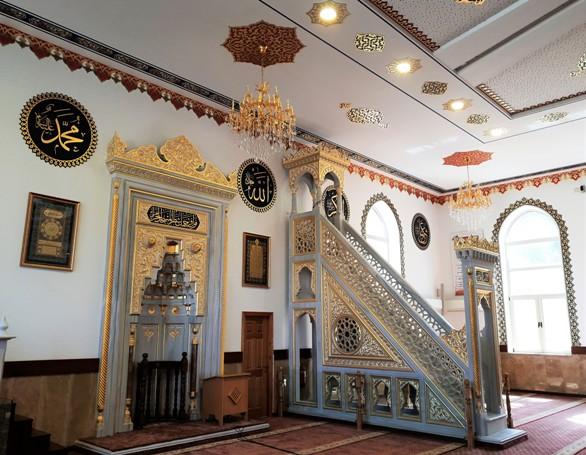
The prayer niche and the darshan hall are made of gold-plated marble, and the floor is covered with luxurious carpets.
The Benedictine Monastery of St. Mary and the Church of the Resurrection
Just near the mosque is one of the most magnificent hidden treasures of the Holy Land, the Benedictine Monastery of St. Mary built in 1141 by the Crusaders.
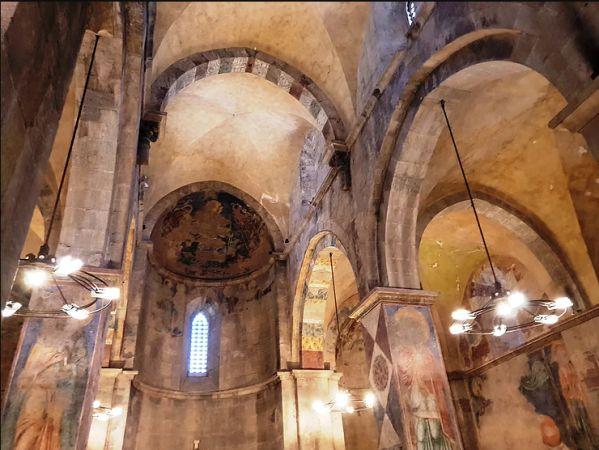
You can listen to the Gregorian prayer chants that are still sung several times a day in this active monastery. About twenty monks and nuns reside here, and make ceramic pottery and candles which you can buy.
Besides the well-tended gardens, the monastery houses the Church of the Resurrection with some of the best preserved medieval frescoes.
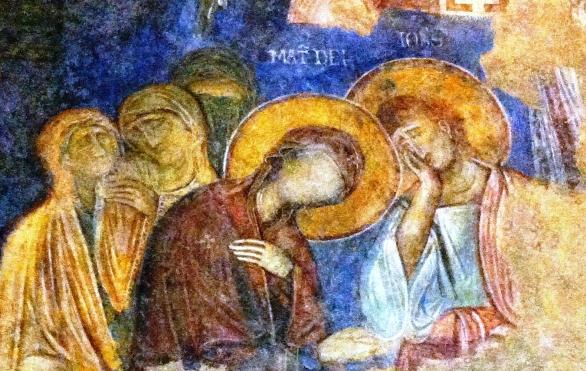
You may wonder why the Crusaders built such a magnificent church in this small village?
Abu Ghosh is considered by many to be the site of Emmaus, mentioned in Luke in the story of two disciples on the road to Emmaus from Jerusalem, who met with and supped with a stranger who was the resurrected Jesus.
In the basement crypt, you can visit the original spring that gave life to the ancient village first established here 10,000 years ago! You can see also see a sign left by the Romans who visited here.
Our Lady of the Ark of the Covenant Church
There is another impressive church in Abu Gosh at the top of the hill, Our Lady of the Ark of the Covenant Church.
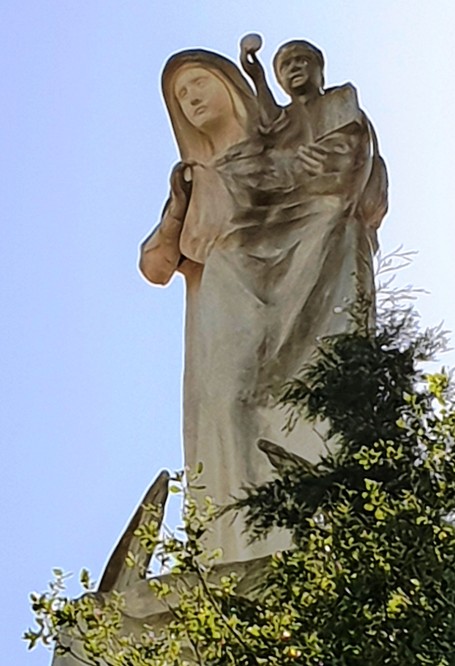
You can see the rooftop sculpture of Mary carrying the infant Jesus in her arms from almost anywhere in the village. At the base of the statue is the Ark of the Covenant with cherub wings. In Christian tradition, Mary carrying Jesus is compared to the Ark holding the tablets of the Ten Commandments.
Abu Ghosh is considered by many to be the Biblical site of Kiryat Ye'arim where the Ark of Covenant resided for 20 years.
The Book of Samuel describes how the Ark was captured by the Philistines, but they were afraid to keep it so they sent to the Jews at Beit Shemesh. They too were afraid to keep it, so they sent it on to Kiryat Ye’arim to the house of Avinadav and his son Eleazar. The modern name of the site in Arabic is Deir el–Azar, indicative of Avinadav’s son’s name. From Kiryat Ye'arim, King David took the Ark to Jerusalem.
The present Catholic church and convent were built in 1924 on the ruins of an ancient Byzantine church. You can see the original mosaic floor.
Abu Ghosh Hummus and Middle Eastern Restaurants

There ares dozens of restaurants along the main road serving distinctive Abu Ghosh hummus, stews, chickens stuffed with rice and pine nuts, all kinds of skewered meats -

a huge variety of salads -
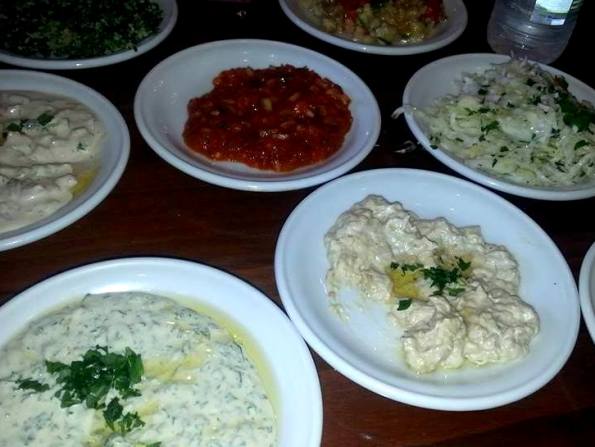
and classic Arabic sweets.
The restaurants compete with each other claiming to be the best in Abu Ghosh, but we think they are all similar, offering classic Middle Eastern food that Israelis love to eat.
Here is a partial list of some of the most well-known eateries:
- Abu Ghosh Restaurant
- The Lebanese Restaurant
- Naji Restaurant
- Caravan Restaurant
- Naura Restaurant
- Muma Restaurant
All the restaurants serve Arabic pastries. Or you may prefer to have a coffee and sweets at at one of the many Arab pastry shops such as
- Mamtakei Hakfar (Sweets of the Village)
- Mamtakei Almuchtar
- and others...
You'll find baked and fried pastries and a variety of baklava stuffed with pistachios, walnuts, almonds and cashews. Or try my all-time favorite, kanafeh.
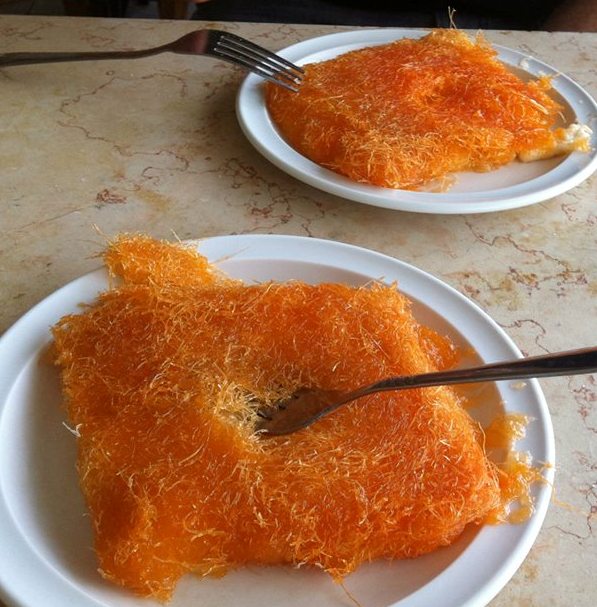
It's a sweet, syrupy, noodle-like pastry stuffed with sweet cheese and best served hot.
On the side, you can drink a fresh Turkish coffee flavored with cardamom, mint flavored tea, or the delicious Hot Sachlav, the 'hot chocolate' of the Arab kitchen. Enjoy!
You may also be interested in:
- Top Ten Must Sees in Israel
- The Essential Christian spots in the Holy Land
- Christian Sites in the Judean Hills
- Private Tours in the Israel Desert
- What to Do in Israel
- Abu Ghosh near Jerusalem
Facebook Comments
Please like us!
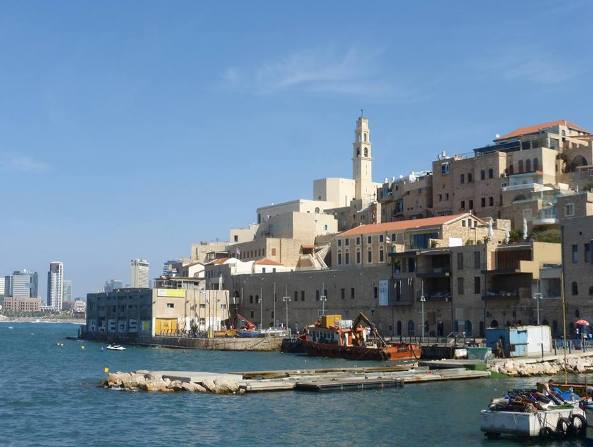
Recent Articles
Our House Guide Levi wins Tripadvisor Traveler's Choice 2020!
Aug 24, 20 05:23 PM
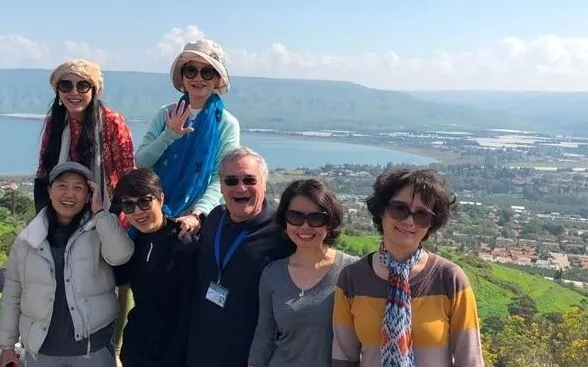
Farewell to Sde Dov Airport in Tel Aviv
Aug 08, 20 07:28 AM

Tomb of Absalom on the Mount of Olives in Jerusalem
Jul 25, 20 12:42 PM
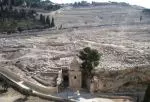
Find a Hotel in Israel
(This is an "affiliate link", which means that if you click and buy something, we earn a small commission at no extra cost to you).
Popular Pages
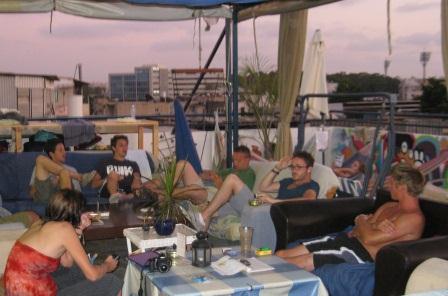
Home About Me Contact Privacy Disclaimer Site Search
Copyright © 2012 - 2020 GoTelAviv.com
- Accommodation Hotels Hostels B&B
- Things to do Trails Attractions Restaurants
- Tourist Services Tour Guides
- English 中文 Français Deutsch Español Português Русский Italiano Polski Українська עברית
Archaeology and History
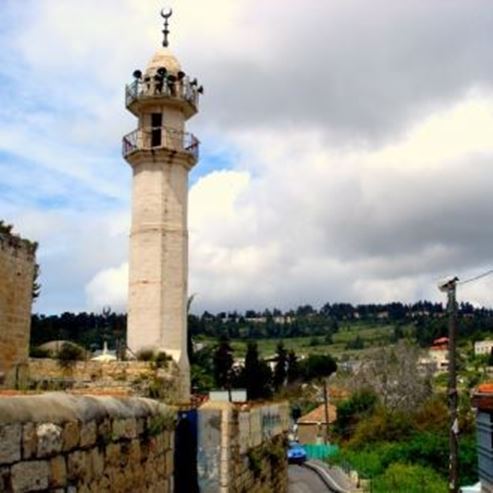
Abu Ghosh is a picturesque village of 6,000. Just a few minutes drive of Jerusalem, is the Old Testament Kiryat Ye'arim and the New Testament Emmaus.
its many tempting Middle Eastern restaurants, sweetshops, ceramic and glass shops and candle store make it the perfect place for a break or an overnight stay at one of its bed-and-breakfasts or at its hilltop convent.
The Crusader-era church built over the village spring, features some of world's oldest medieval frescos.
The convent on the hill reveals beautiful panoramas. On Shavuot (Pentecost) and Sukkot (Tabernacles) both churches host an international vocal music festival.
Taken: Ronen Markos.
Similar attractions
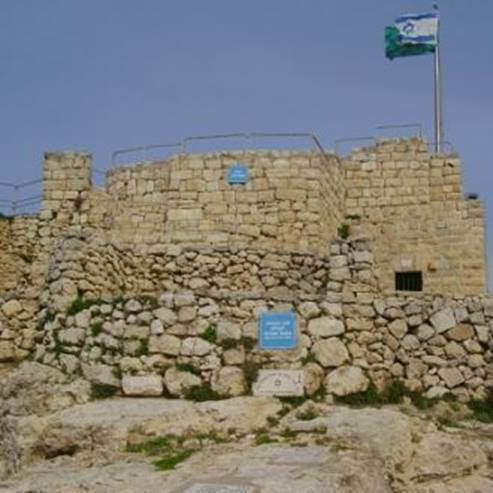
Castel National Site
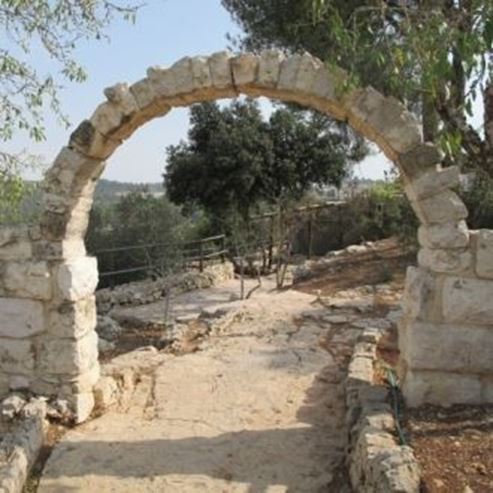
Hagan Hatanachi
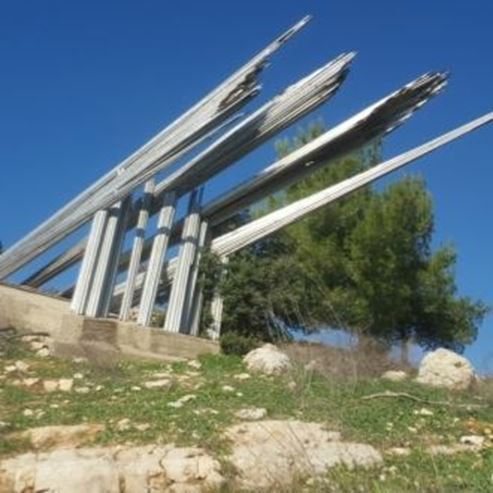
The Monument Of Heroism
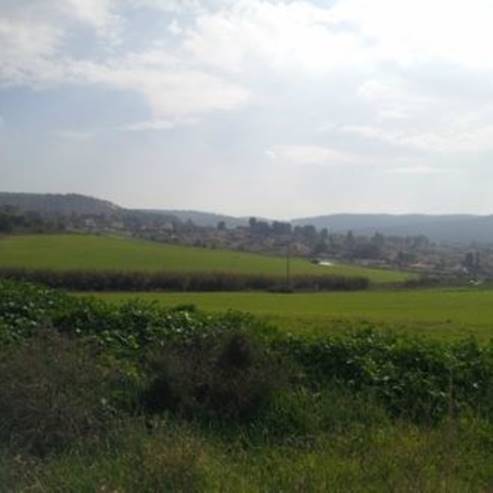
Yitzhak Rabin Park
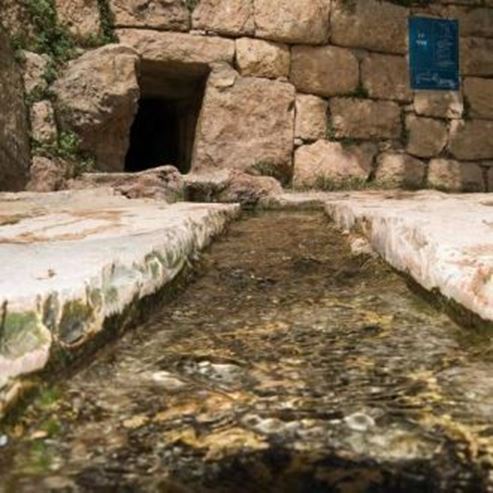
Mount Tayasim, Ein Tayasim
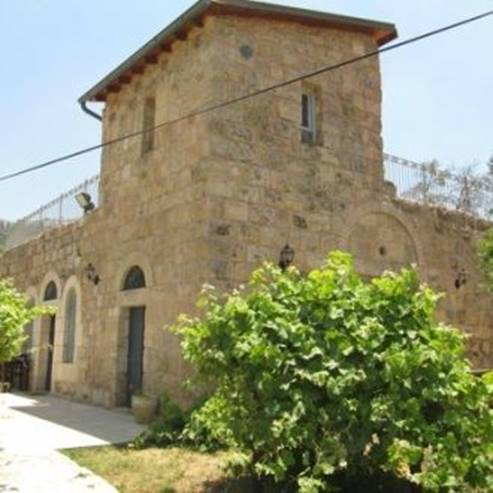
Beit Yellin In Motza
nearby trails.
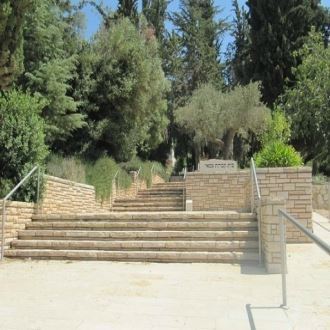
Military cemetery of the Harel Brigade
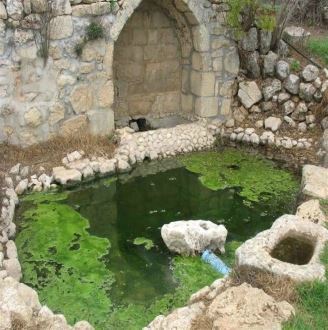
From Ein Sataf To Ein Karem Track
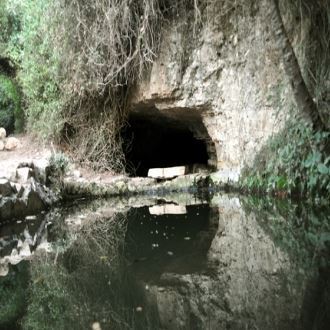
Sde Telem - Enot Telem National Park
nearby restaurants.

Pizza Domino- Abu Ghosh
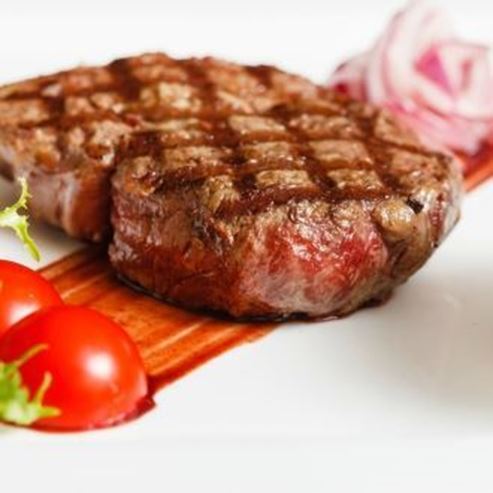
Abu Gosh Restaurant

Cafe Hillel - Kiryat Anavim

The Lebanese Restaurant - Abu Gosh

Cofix - Kiryat Sharet, Holon

Mcdonalds- Mevaseret Mall, Jerusalem
- 2 Get around
- 4.1 Festivals and Events
Abu Ghosh is an Arab-Israeli town of 7,500 people (2018) in Israel . It is in one of the earliest areas of human habitation in Israel. Archaeological excavations have revealed three Neolithic settlement phases, the middle phase is dated to the 7th millennium BCE. In 2017, Abu Ghosh was described as a "model of coexistence."
Abu Ghosh is just outside Jerusalem on the road to Tel Aviv .

- 31.80735 35.10247 1 Church of Our Lady of the Covenant , Abu Ghosh , ☏ +972 2-5342818 . M–Sa 08:30–11:30, and 14:30-17:00 . Located at the north-west part of the village of Abu Ghosh . The church is located at the summit of Tel Kiryat Ye'arim. The site is identified with the biblical Kiryat Ye'arim, where the Ark of Covenant was brought after it was captured back from the Philistines. The biblical story was the impetus to constructing a church at this site. A church was first constructed at this site during the Byzantine period, which was later on destroyed in 614 during the Persian conquest of the region. The church was established in 1924 together with a women monastery on the remains of the Byzantine period church. Since the 1980s music festivals have been held occasionally at the church. Free .
- 31.807428 35.107386 2 The Benedictine monastery in Abu Ghosh ( at the center of the village ). It is best known for the Crusader church that contains remains of a 12th-century frescoes. The church was built over a spring. Abu Ghosh's main mosque is adjacent to the monastery.
- The Chechen mosque in Abu Ghosh . The second largest mosque in Israel. The mosque has four minarets and was funded and built with the sponsorship of the Chechen government.
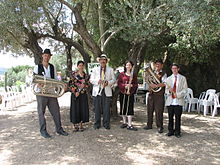
Festivals and Events
- Abu Ghosh Festival of Music . Held every year during the fall and late spring. As part of this festival, various Israeli and international musical groups perform in some of the oldest churches located within the village of Abu Ghosh.

Abu Ghosh is famous for its food, particularly its hummus (chickpea paste). One of the restaurants in Abu Ghosh held a Guinness record for largest hummus dish, weighing 4 tons.
- Lebanese Restaurant , 88 Hashalom St , ☏ +972 2 533-5561 . Traditional Arab cuisine in the Lebanese style. The Lebanese Restaurant is frequented by locals, Israelis and tourists alike and serves, amongst other reasonably priced delicacies, what is arguably the country's best hummus. Many Israeli notables have eaten here. In good weather, you can eat under the mulberry tree that this gem of a restaurant is built around.
- Abu Ghosh Restaurant , 65 Hashalom St , ☏ +972-2-533-2019 . Daily 11:00-00:00 . Traditional Arab cuisine, anr stuffed fish. ₪40-100 .
- Mifgash Caravan Restaurant , HaShalom Street 27, Abu Ghosh , ☏ +972 2-5342744 . Daily 10:00-22:30 . Traditional Arab cuisine.
- Naura , HaVadi Street 9, Abu Ghosh , ☏ +972 2-5341175 . Daily 09:30-ladt customer . Traditional Arab cuisine.
- 31.80829 35.10528 1 The Jerusalem Hills Inn .
- Has custom banner
- Has mapframe
- Has map markers
- See listing with no coordinates
- Do listing with no coordinates
- Eat listing with no coordinates
- Has routebox
- Has Geo parameter
- Jerusalem Hills
- All destination articles
- Usable cities
- Usable articles
- City articles
- Pages with maps
Navigation menu
- Share full article
Advertisement
Supported by
Jerusalem Outings Go Beyond the Biblical

By Joshua Hammer
- June 10, 2011
CASBAH-LIKE alleys lined with stone houses wound upward toward hills cloaked in pine and cypress trees. Hand-painted signs beckoned visitors to the shops and studios of jewelers, potters and other artisans. Just past a popular brunch spot with a packed terrace, Christian pilgrims from Russia, Poland and the United States gathered around a spring where Mary and Elizabeth, the mother of John the Baptist, were said to have met.
Tucked in the arid hills on the western edge of Jerusalem, the community of Ein Karem was teeming with tourists and with residents on a March afternoon. It was hard to remember that this was a Saturday, at the height of the Sabbath, and that the rest of Jewish Jerusalem had stopped dead in its tracks.
As Newsweek’s bureau chief, I lived in Jerusalem from 2000 to 2004, and distinctly remember how totally the western — Jewish — side of the city shut down at the start of the Sabbath. At 3 p.m. on Fridays, the streets emptied of traffic, commercial districts cleared out, and quiet contemplation pushed aside the tensions of this hectic, largely working-class city — tensions aggravated at the time by the al-Aqsa intifada. I eventually came to savor the silences of the Sabbath; even so, there were Saturdays when I yearned to escape the city’s religious aura and bask in a secular atmosphere. Frequently, that meant exploring a few enclaves a short drive from downtown Jerusalem, where nonreligious Israelis go to sip cappuccinos, shop for art and antiques, picnic, hike in the hills and otherwise forget that they live in one of the holiest cities in the world.
I recently reacquainted myself with three such places: the Arab-Israeli town of Abu Ghosh, the secular Jewish artists’ colony of Ein Karem, and the hiking trails of Ein Sataf in the Jerusalem Forest. It’s easy to combine a visit to all three places in a single morning and afternoon, returning to central Jerusalem by dusk. All are reminders that Jerusalem offers far more than the Old City, the Temple Mount and other sites of biblical resonance; for those in the know, there are wonderful, more obscure corners that offer color, character and history — not to mention great food.
A good place to start is Abu Ghosh, a town of minarets, packed-together Ottoman houses and Middle Eastern restaurants that lies seven miles west of Jerusalem, off the Tel Aviv-Jerusalem highway. The Muslim town has maintained close ties to Israel’s Jews, who arrive here en masse for weekend brunch, especially in spring and summer.
Abu Ghosh has a turbulent history. Though inhabited since the Neolithic era, it was officially established in 1520 by the Abu Ghosh clan, landowners of Circassian origin, who received a lucrative concession from the Ottoman Sultan to collect taxes from travelers on the Christian pilgrimage route between Jaffa and Jerusalem. During the British Mandate period, Abu Ghosh’s largely Muslim population had good relations with Jews; Abu Ghosh sat out the 1948 war, when Arab gunmen used the surrounding hills to ambush convoys bringing supplies to besieged Jerusalem. Nevertheless, Israel interned many of its residents after the war; at the same time, Jordanian authorities denounced Abu Ghosh residents as traitors. Today, the town is one of the only surviving Muslim villages in the area.
A friend from Berlin and I arrived there late on a Saturday morning, just before the weekly invasion of hungry Jerusalemites. Past the entrance to the village, beside a cluster of Arab men selling pomegranate juice, stands one of the most impressive vestiges of the Crusader era, the Crusader Church of the Resurrection, built in the 12th century. “More perfectly preserved than any other ancient church in Palestine” is the way the mid-19th-century travel writer Edward Robinson described this handsome, Gothic-style structure of Jerusalem stone that rises in a lush walled garden of date palm trees, scattered Corinthian columns and a burbling fountain. Next door stands a Benedictine abbey. The church was closed to visitors on Saturday morning, but we talked our way into the garden, admiring views of the surrounding forest until we were shooed away by the impatient priest.
At noon we headed for one of the most popular gathering spots, the blandly named Lebanese Restaurant (88 Hashalom Street; 972-2-533-5561). With friends from Tel Aviv, we sat at a table in a shady courtyard dominated by mulberry trees and, for 30 shekels apiece, about $9 at 3.4 shekels to the dollar, feasted on pita bread, pickles, falafel and hummus, washed down with fresh lemonade and chased by Arabic coffee. Gradually the place filled up with Israeli Jewish families. By now the main drag in front of the Lebanese Restaurant was bumper-to-bumper with cars, nearly all bound for one of a dozen popular restaurants here.
Abu Ghosh’s culinary reputation has crossed Israel’s borders: In January 2010, Jawdat Ibrahim, the owner of the Abu Ghosh Restaurant (65 Hashalom Street; 972-2-533-2019) was enshrined, briefly, in the Guinness Book of World Records for preparing the largest plate of hummus ever — 8,992 pounds of it. Alas, Ibrahim’s record fell only four months later — to a restaurant in a village east of Beirut, Lebanon.
We left with full stomachs, and 10 minutes later, turned off at the Jewish community of Mevasseret Zion, and followed winding roads through the Jerusalem Forest to Ein Karem. Situated inside a gorge and dominated by a golden-domed Russian Orthodox church perched on a hilltop, Ein Karem, now incorporated into municipal Jerusalem, is believed by many Christians to be the birthplace of John the Baptist.
Out and About in Jerusalem
View Slide Show ›
During the war of 1948, 300 Arab guerrilla fighters from Ein Karem, with support from Iraqi, Syrian and Egyptian troops, battled Jewish soldiers and ambushed convoys on the Tel Aviv-Jerusalem road. After the April 1948 massacre by Jewish paramilitary forces of 120 Arab civilians in the nearby village of Deir Yassin, Ein Karem was evacuated, and resettled by Israelis. The Muslims are all gone now, and as I wandered through the village, one of the few to survive the 1948 war with most of its buildings intact, I was keenly aware of Ein Karem’s controversial past and couldn’t help but notice that there was no mention — in tourist guides or signs at historic sites — of the Arab evacuations.
Today, Ein Karem is both a secular Jewish oasis and a pilgrimage site for Christians who are drawn by several 19th-century churches and monasteries tucked away on winding country lanes, among them: Convent of the Sisters of Our Lady of Zion, the Muscovia Monastery and the Church of the Visitation. We visited a handful, following paths that wind past Arab houses with Moorish arched window frames; groves of cedar and pine; and gardens blooming with lavender, geraniums and daisies. Each turn in the road offered superb vistas of the Jerusalem Forest and villages hugging the steep slopes.
We finished our visit to Ein Karem with a bite at Agua, a sidewalk cafe (1 Hamaayan Street; 972-2-644-9494); homemade ice cream at Sweet ’N Karem, in the town center; and a shopping expedition for ceramics at Ruth’s Tile Shop, on the second floor of an Ottoman-era house.
Needing some exercise after all that eating, we got back into the car and followed hairpin turns through the Jerusalem Forest, toward some of the best hiking trails in the city. Our destination was Ein Sataf, a 10-minute drive from Ein Karem. This nature and agriculture reserve is named for yet another Arab village that fell to Israel during the 1948 war. North African Jews settled here briefly after the conflict, then it was taken over by an Israeli paratrooper unit. Twenty years ago the Jewish National Fund took possession of this hillside sweep of pine and cypress forests, terraced the slopes, and began cultivating olives, figs and pomegranates using ancient methods. The fund also carved out trails through the reserve.
By the time we arrived in the midafternoon, Ein Sataf was busy with hikers, runners and barbecuers. We found our way to a wide, gently sloping trail that wound for several miles along a wadi, or gorge. In a clearing in the forest below us, an Israeli family was grilling lunch; mellifluous Hebrew voices and the pungent smell of grilled chicken wafted through the air. The path wound gently through pine groves and fields of thyme, which some hikers were gathering. Not far from the trail, a pair of springs flows into an ancient storage cistern carved out of limestone, then funnels through irrigation channels to the agricultural terraces.
A 45-minute hike would have taken us to the cave of Shai Seltzer, a goatherd and cheesemaker nonpareil, who sells goats’ milk cheeses produced by three families with permission to live on here. But after a long day of exploring the ancient and modern worlds around Jerusalem we were ready to call it quits. We got back on the road and headed back to the center of the city, to watch Jerusalem emerge from Shabbat and come alive on Saturday night.
An article last Sunday about day trips just minutes from downtown Jerusalem , including the village of Ein Karem, now a secular Jewish artists’ colony thought by many Christians to have been the birthplace of John the Baptist, erroneously attributed a distinction to former Israeli Prime Minister Ariel Sharon. Mr. Sharon did not participate in the 1948 massacre of more than 100 Arab civilians by Jewish paramilitary forces in the village of Deir Yassin, near Ein Karem. The article also misstated part of the name of the organization that controls the Jerusalem Forest. It is the Jewish National Fund, not the Jerusalem National Fund.
How we handle corrections
Top Things to Do in Abu Ghosh, Israel
Places to visit in abu ghosh.
- 5.0 of 5 bubbles
- Good for a Rainy Day
- Good for Kids
- Budget-friendly
- Good for Big Groups
- Adventurous
- Hidden Gems
- Good for Couples
- Honeymoon spot
- Good for Adrenaline Seekers
- Things to do ranked using Tripadvisor data including reviews, ratings, photos, and popularity.

1. Saxum Visitor Center
2. St. Mary of the Resurrection Abbey

3. Benedictine monastery in Abu Ghosh
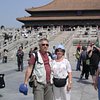
4. Beautiful People
What travellers are saying.

all about Israel
- Israel Home Page
- North Israel
- Central Israel
- South Israel
- Jerusalem and Surrounding
- Israel Leaders
- History and Conflicts
- Israel Today
- Cuisine And Recipes
- Useful Links
- Privacy Policy
The Israeli Arab Village of Abu Ghosh is situated about 10 km west of Jerusalem, just off the main road from Tel Aviv. During Israel’s War of independence , out of all the Arab villages in the area, only the residents of Abu Ghosh remained neutral and, in many cases, helped by assisting in keeping the road to Jerusalem open so that essential supplies could be sent to the besieged Jewish residents of the city. To this day, relations between the village of Abu Ghosh and the Jewish community of Israel remain friendly and cooperative.
More than 6000 years ago, during biblical times, Abu Ghosh was called Kiryat Ye’arim and was a center where the Ark of the Covenant was kept up until it was taken to Jerusalem. About 1,500 years ago, during the Byzantine era , a church was built in the village. During Crusader times, the village was attributed to being the place of Emmaus (The place where after his resurrection, Jesus revealed himself to his disciples). This is the site of the beautiful Benedictine Monastery.
One of the most beautiful crusader buildings to have survived in Israel is the Abu Ghosh Benedictine Monastery built about 1000 years ago on a water spring site. In the 19th century, this crusader church was handed over to the Benedictine Order by the French Government after careful restoration. On the monastery walls, frescoes from the 12th century are still in evidence, and a small spring can be seen flowing from the monastery’s crypt. The monastery is divided into a section for nuns and a section for monks.
At the highest point of the village and facing the inspiring views of the Jerusalem Hills and surrounded by gardens is the lovely Church of our Lady of the Ark of Covenant (The Church of Notre Dame de l’Arche d’Alliance) was built on the ruins of an ancient Byzantine Church. In the Church Courtyard, there is a large statue of the Virgin Mary, visible from all points of the compound. The convent itself belongs to the French order of St.Josef de l’apparition, and the imposing church is home to the Abu-Gosh Liturgical Festival. During the 1948 War of Independence, the convent was used as a military hospital.
During Shavuot (the festival of the first fruits) and Sukkot (The Feast of Tabernacles), both the Church and the Benedictine Monastery hold vocal music festivals. Groups and Choirs from around the world participate in these festivals, which music lovers from both Israel and abroad attend.
The village has several excellent restaurants. If the word hummus is mentioned, Abu Ghosh immediately comes to mind as it is known as the countries hummus center with its different varieties of garnishes and spices. Therefore, visitors should definitely put the village of Abu Gosh on the list of places to visit when touring Israel .
- It is currently recommended to avoid all non-essential travel to some parts of this area.
Plan Your Trip to Abu Ghosh: Best of Abu Ghosh Tourism

Explore Abu Ghosh
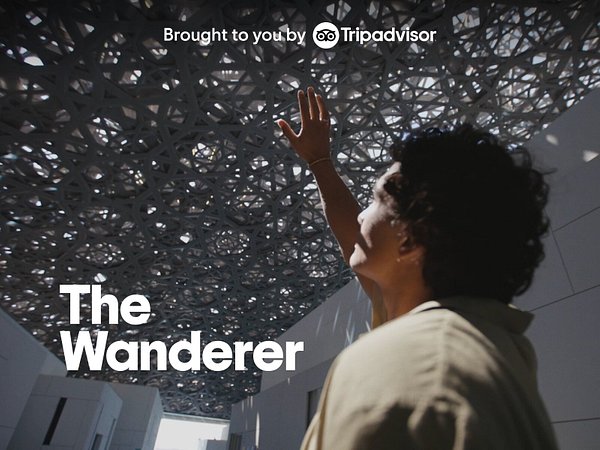

Watch The Wanderer
Essential abu ghosh.

Abu Ghosh Is Great For
Eat & drink.

BibleWalks 500+ sites
Abu Ghosh Crusaders church
A Benedictine monastery in Abu Ghosh, with a 12th century Crusaders church, near the ancient road to Jerusalem.
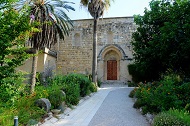
Home > Sites > Judea > Abu Ghosh > Crusader Church
Overview Location History Photos * Aerial Views * Spring * Exterior * Interior * Crypt * Garden Etymology Biblical Links
A Benedictine monastery in Abu Ghosh, adjacent to Tel Kir’yat Ye’arim, on the side of the strategic ancient road to Jerusalem. This 12th century church is one of the most beautiful and interesting Crusaders structures in the Holy Land. It was built on the ruins of a Roman period water reservoir, and an Abbasid caravansarai.
The following aerial view shows the area around the abbey, within the village of Abu Ghosh. Adjacent to the site is the spring (‘Ain el ‘Azir). North west of the site (alt. 680m), situated on a high hill (alt. 758m), is the archaeological mound of Kiriath Jearim (Kir’yat Ye’arim) and the Abbey of the ark of Covenant.
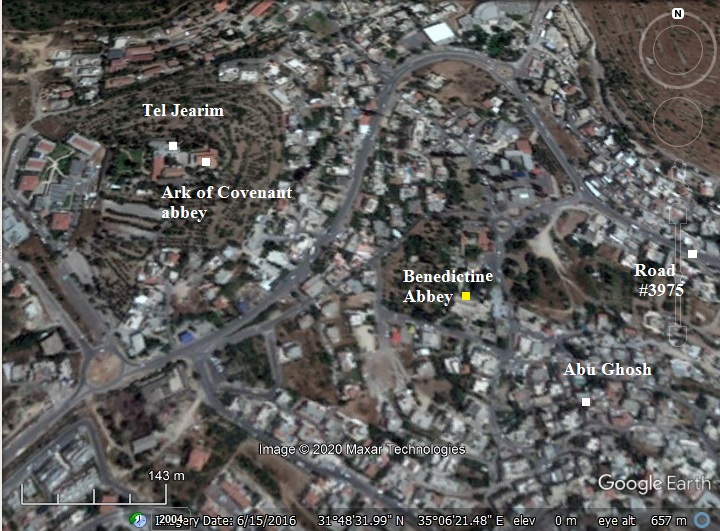
- Biblical periods
Ruins of the Israelite city of Kiriath Jearim are located on a hill to the west of the Benedictine monastery. Kiriath Jearim (Hebrew: Kir’yat Ye’arim – House of woods”) is the place where the ark of Covenant was stationed after the Philistines returned it to the Israelites. Later, King David moved it to the temple in Jerusalem.
- Roman period
A Roman legion, Legio X Fretensis, had a station house and guard post in Abu Ghosh until the end of the 3rd century AD. An inscription of this legion on a stone is displayed on the wall of the church. Their post was adjacent to the Abu Ghosh spring.
During this time a large pool was built to store the waters of the spring. The pool’s estimated size is 16.25 x 20.70. It was later incorporated into the crypt of the Crusader Church. Two staircases were cut into the rock, descending down to the pool. These stairs were also incorporated into the crypt.
In 1923 Benedict archaeologists unearthed two tombs with rolling stones near the Church. They were dated to the Second Temple period.
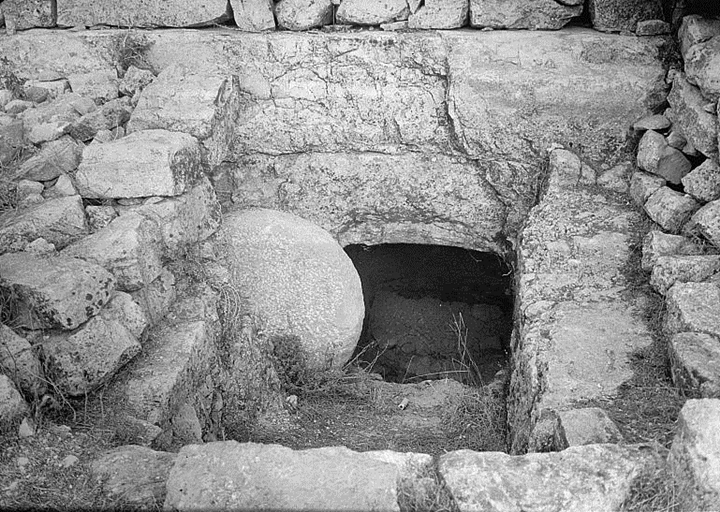
Abu Ghosh – Jewish Tombs with Rolling stones – Matson collection 1940-1946; Photos of the Library of Congress
- Early Arab period
An inn was constructed near the Abu Ghosh spring in the 9th century (Abbasid Caliphate), servicing the pilgrims to Jerusalem. Its rooms, surrounding a courtyard, were built on the western side of the Roman pool. An inner pool in the center of the courtyard was fed from the Roman pool. The entrance to the inn was on the north side, opened to the main road to Jerusalem.
- Crusaders period
A Church and a monastery was built here in ~1140 by the order of the Hospitallers. The eastern side of the church was built over the Roman pool, while the western side was built over bedrock.
The Knights named their order after John, and were called the “Knights Hospitallers of St. John”, or commonly known as the Hospitallers. They became one of the important military orders defending the Holy Land, and established other structures and installations such as the knights halls in Acre (1104).
The church was named “ Church of the Resurrection “, as the Crusaders associated the place to Emmaus, which is referred in the Gospel of Luke. This Gospel tells about the meeting between Jesus, after his resurrection, and the two companions, on the road to Emmaus ( Luke 24: 13-35 ):
“And, behold, two of them went that same day to a village called Emmaus , which was from Jerusalem about threescore furlongs….”.
There are different Biblical versions of the location of Emmaus; some indicate sixty stadia (about 10KM) or hundred and sixty stadia (about 32KM). The former range fits this location, while the latter range fits the ruins near Latrun .
- Saladin and Mameluke period (1187-1516)
The area was lost to the forces of Saladin in 1187, and the church was abandoned.
The Mamelukes built a new caravansarai (inn) and stables in 1350-1400. The western wall of the caravansarai was joined to the eastern wall of the Crusader church. A mosque was added on the eastern side. The inn continued to serve the caravans passing thru Abu Ghosh until the 16th century. The mosque is still standing and functioning to date.
- Ottoman period (19th Century AD)
In the 16th century an Arab family, named Abu Ghosh, settled here. According to a tradition, they were of Chechen descent, and fought with the Ottoman Sultan Selim I. From the beginning of the 16th century until 1834 the family controlled the pilgrimage route from Jaffa to Jerusalem, imposing tolls on the pilgrims.
The French obtained the property in 1873. Its ruins were cleared out on 1894 and the finished abbey was handed to the Benedictine order in 1901. Most of the original Crusader church remained, and the original frescoes were preserved.
- PEF survey:
The area around the site was examined in the Palestine Exploration Foundation (PEF) survey (1866-1877) by Wilson, Conder and Kitchener. A section of their map is shown below, with the site appearing here as “Kuryet el Enab”. A major Roman road passed nearby, indicated by double dashed lines.
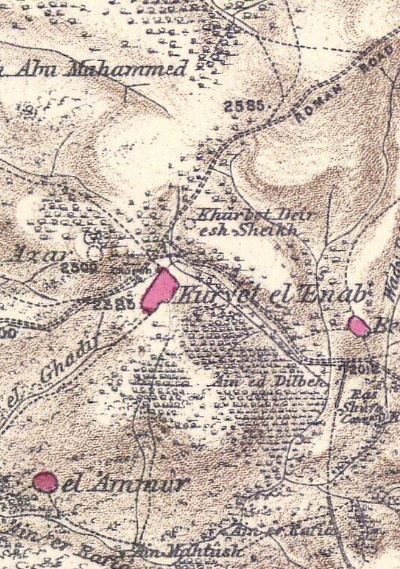
Part of Map Sheet 17 of Survey of Western Palestine,
By conder and kitchener, 1872-1877., (published 1880, reprinted by lifeintheholyland.com ).
The ruined Church was illustrated in the PEF survey ( Sheet XVII, Volume 3, pp. 132-143 ). This view is from the north east side, viewing the entrance to the church. They named it as the Church of St. Jeremiah, based on their apparently mistaken identification of the village as Anathoth – the birthplace of prophet Jeremiah.
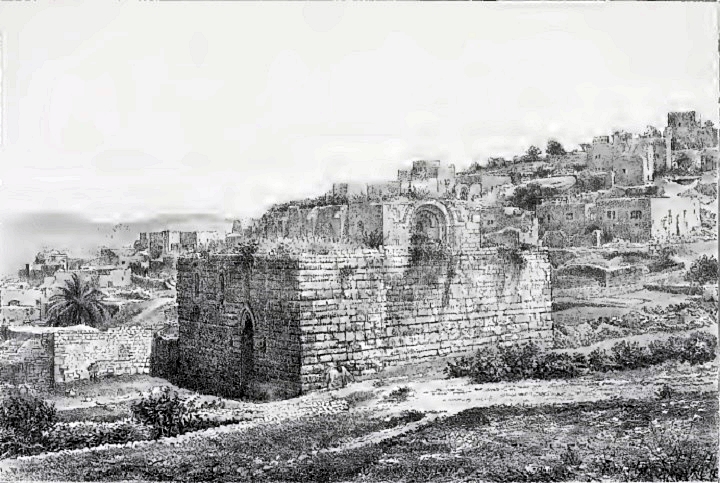
Their description in 1875 provides a valuable description of the state of the Crusader church, 2 years after the ruin was purchased and before it was cleaned.
“The ruined Church of St. Jeremiah, in the valley, is one of the best preserved specimens of Crusading work in the country. The building is remarkable from its unsymmetrical plan—the east wall is 2 1/2 feet longer than the west. The length of the building outside is 90 feet ; the breadth on the west, outside, is 68 feet. The side walls are 8 feet thick ; the west wall is set back twice in its height, the base measure being 12 feet. The nave apse is 13 1/2 feet diameter, the side apses 11 1/2 feet. The church consists of four bays, with heavy square piers, 31/2 feet side. The church has a crypt beneath, occupying the two eastern bays, and having also three apses. There are two galleries under the aisles, 20 feet long, 3 feet broad, running west from the crypt. They seem to have formed a communication between the crypt and the church above, but they are now much choked up with earth. The entrance to the crypt is now on the north, by a side door, with steps within. In the crypt is a spring, with steps leading down to it from the floor. The nave of the church has a clerestory with windows ; the total height to the roof from the church floor is about 50 feet ; the crypt is 17 feet high, in addition to the 50 feet”.
The plan of the church is illustrated here; on the left is a top view, while on the right is a cross section along the line A-B.
Their report provided details on the interior:
“The finest feature of the church is the west window of the clerestory, which is pointed so slightly as to appear almost semicircular. The arches of the door and remaining windows are of the same character. The vaults are all groined; those of the nave roof are supported on dwarf columns, or brackets, with capitals of Gothic design, like those of the church of Samaria. The masonry of the outer walls is extremely irregular, the courses not being continuous horizontally. Small and large stones are used indiscriminately, and the dressing is very rough. Many of the stones are drafted, especially the corner stones. Well-dressed stones of good size, not drafted, are also used at the corners, and the general appearance is that of a building reconstructed from older material. The masonry of the clerestory is, however, well dressed throughout. There are buttresses between the windows outside on this story, supporting the thrust of the roof, but this arrangement is not continued on the lower part of the building. The joints of the masonry are very broad, and are patched with chips of stone ; the vertical joints are not always properly broken ; the drafted stones have rustic bosses with a considerable projection. Three or four kinds of dressing are observable. 1st. The undrafted corner-stones have a diagonal dressing with a sharp pointed instrument ; in some cases the instrument was used in two directions, giving a criss-cross pattern. 2nd. The smaller masonry in the apse interiors has lines all vertical, cut with a toothed instrument. 3rd. The piers of the crypt are dressed with a blunt instrument, used at right angles to the face of the stone. 4th. Hammer-dressed stones occur on the exterior. The north door has an arch more decidedly pointed than the windows. The foregoing list gives an idea of the comparative frequency with which the various signs occur. The Maltese cross is twice repeated on the north-west corner of the outer wall. In the crypt are found other marks. The only mark used on the piers is the hour-glass, or two triangles with apexes joined. Of these masons’ marks a majority occur in the Muristan at Jerusalem, at Kaukab el Hawa, and at Beit Jibrin—all places dating about 1140 a.d. This would agree with the arches of the building, which are just of the transition period, between the round and pointed arch. The building is not mentioned in any Crusading Chronicle, so that its date is unknown historically. Visited 12th February, 1875”.
A view of the area, with the ruined church, is here on a photo from the end of the 19th century. The photo was captured from the main road to Jerusalem.
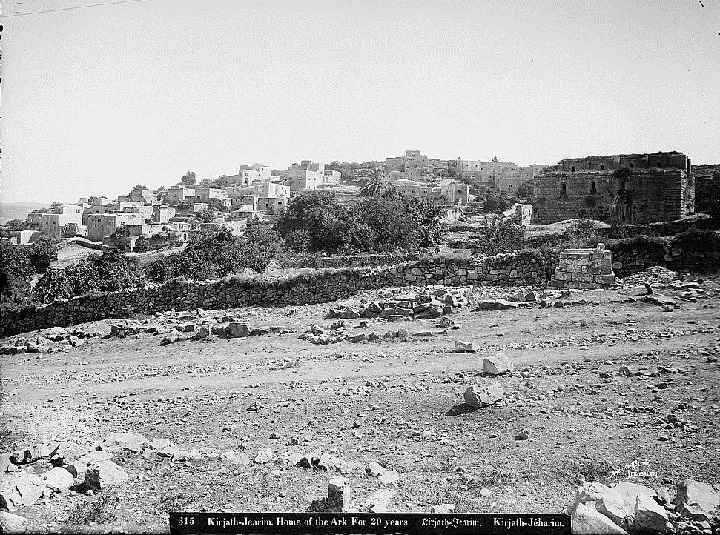
Abu Ghosh – View of the church from the north east side – American Colony 1898-1914; Photos of the Library of Congress
Another photo shows the church from the south.
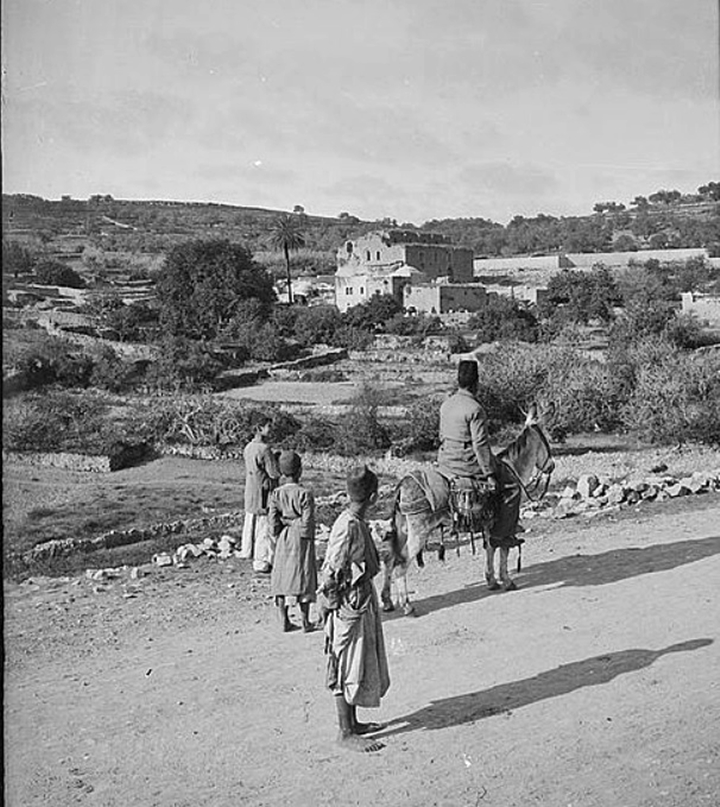
Abu Ghosh – View of the church from the south – American Colony 1900-1920; Photos of the Library of Congress
Modern Period
A view of the north west corner of the church is seen here, captured on 1941.
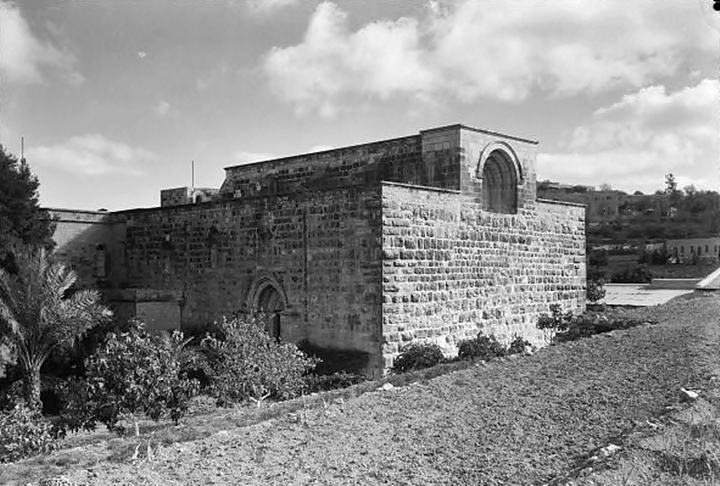
Abu Ghosh – View of the church from the NW – Matson collection 1941; Photos of the Library of Congress
Excavations of the area, immediately east and south of the church, were conducted in 1944. The archaeologists unearthed remains of the Abbasid caravansarai and Roman structures.
The monastery is opened to the public, and is a recommended stop on the way to Jerusalem. Standard visiting hours, except Sundays and feast days, are 8:30-11:00 and 14:30-17:30.
(a) Aerial Views
A drone view from the north side shows the area of the Benedictine monastery. The Church is seen in the center, behind the buildings of the monastery. To its left is the minaret of the old mosque. In the top far right background is Tel Kiriath Jearim.
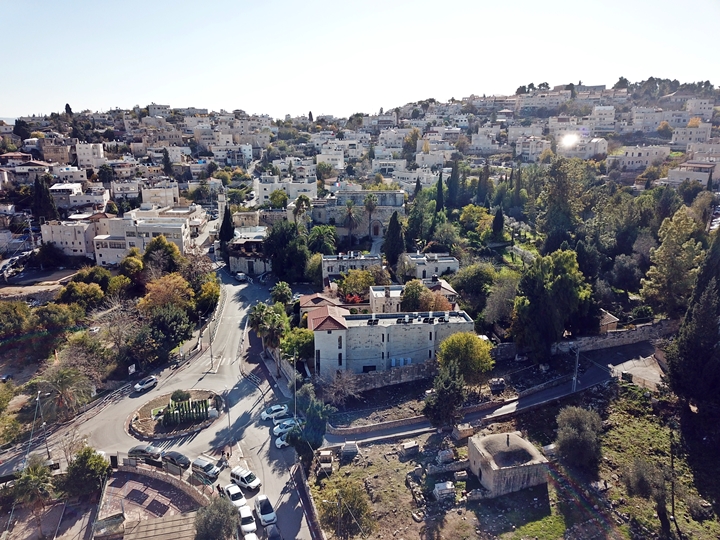
In this cover image of the video: the Crusaders church is in the right side, and the old mosque is on the left.
Captured on December 2020
(b) Spring outlet
A mosque is adjacent to the walls of the monastery, which was built by in 1350-1400.
On the north east side of the mosque, and east of the monastery, is an outlet of the spring of Abu Ghosh. Its waters come from the spring located in the crypt of the church. The water flows thru a hole in the wall, filling a small pool that the worshipers cleansed their feet prior to entering the mosque.
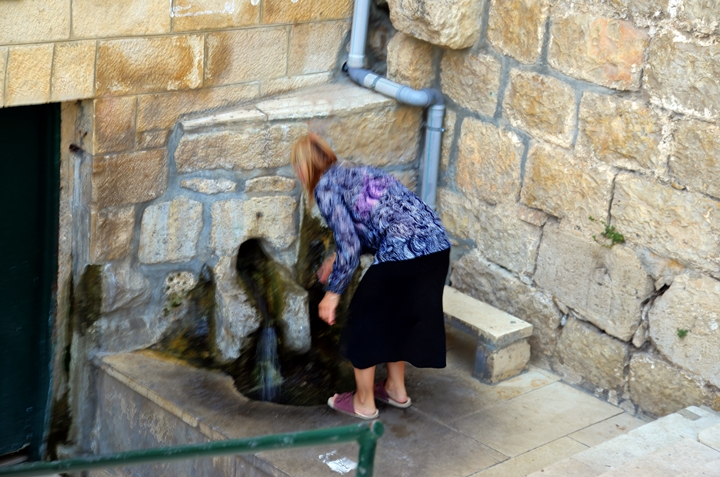
A marble column stands near the spring, once taken from the ruins in the vicinity.
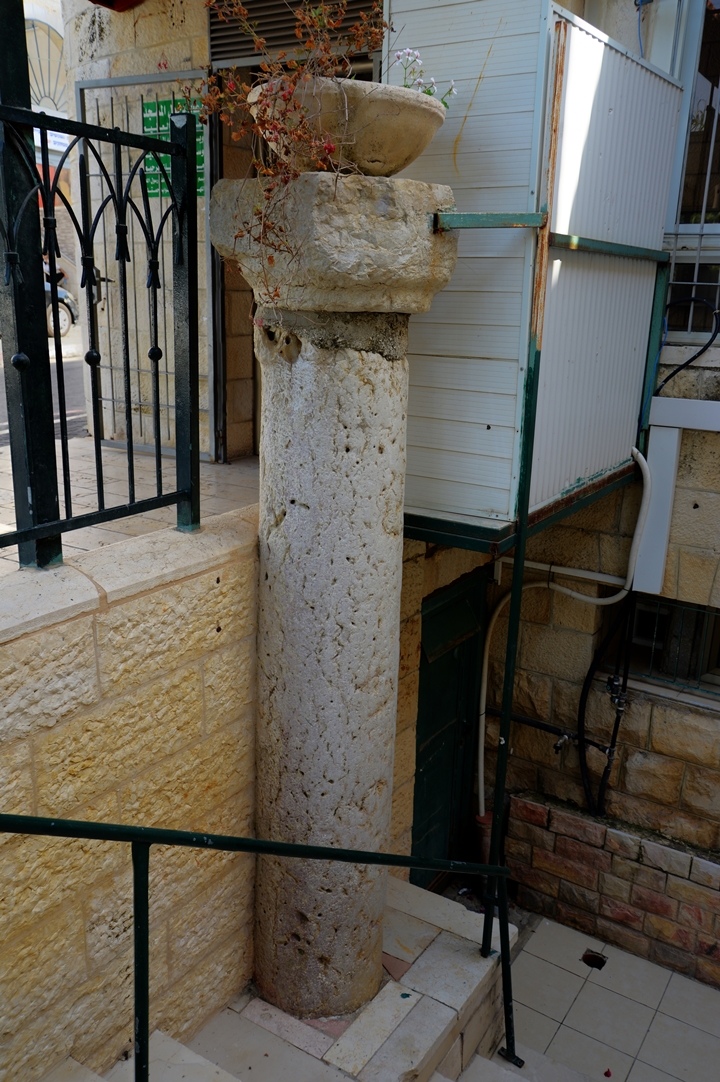
(c) Exterior
Public entry to the monastery is from the eastern gate. After entering into the courtyard of the compound, a view of the building is seen on its south side.
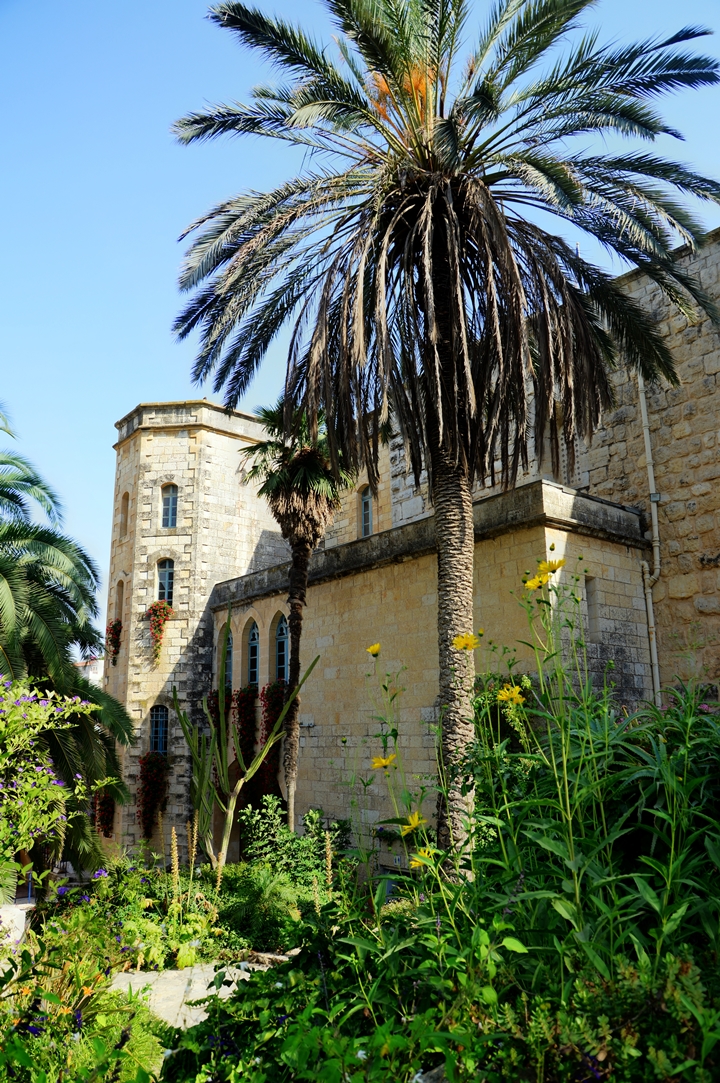
The public entrance into the church is from the north side of the building.
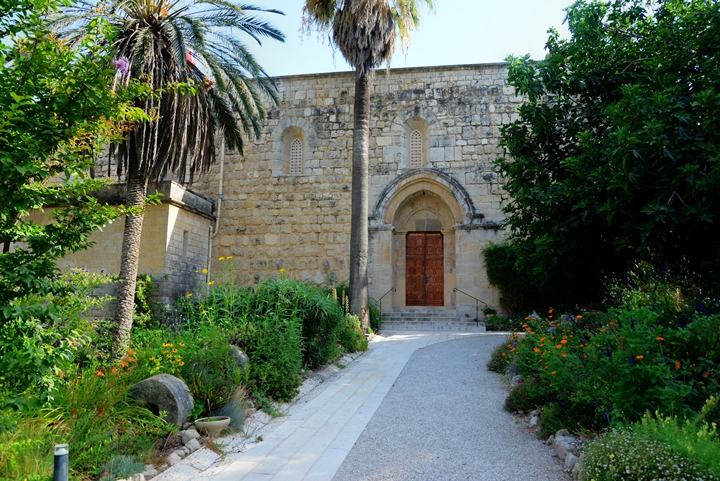
A closer view of the entrance door to the church:
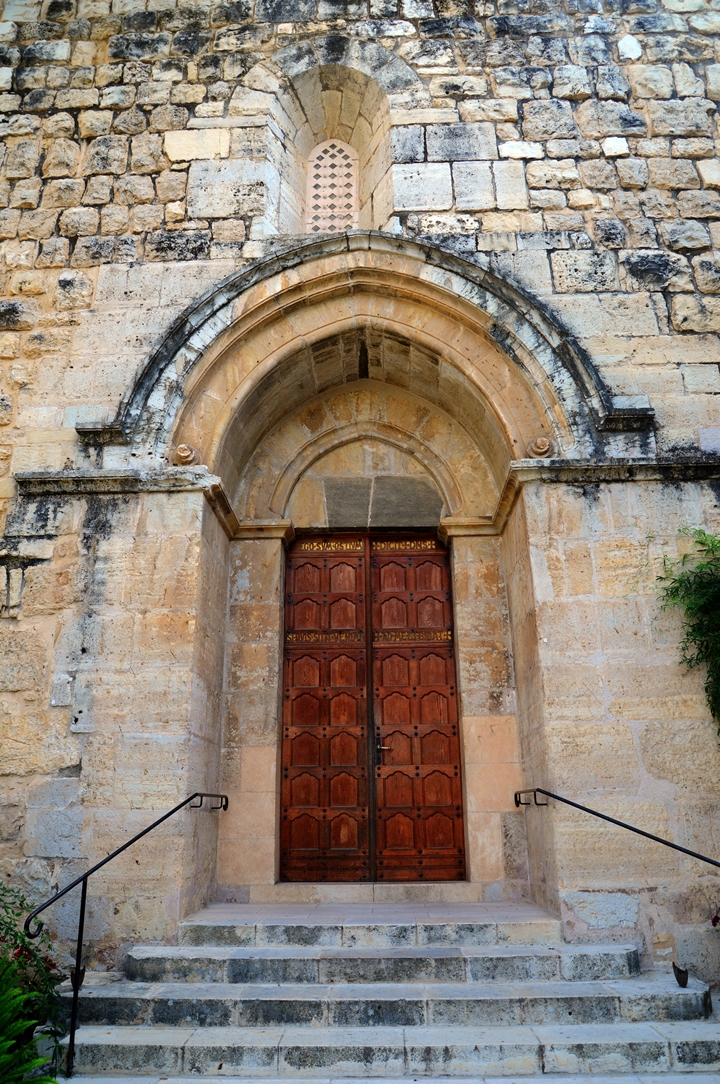
(d) Interior – Ground level
The plan of the ground level of the church consists of a central nave, seen here below, and two naves on both sides.
Each aisle terminates on the eastern side in a semi-circular apse, with a pointed semi-dome embedded on top. The central aisle is unique, having a east facing window, set just above the lower cornice.
The size of the Church is 27.5m x 20.6/21.3, with 2.5m wide walls.
The following photo shows a closer view of the main altar in the eastern edge of the central nave. It is taken from the southern aisle.
The following photo is of the northern aisle.
On the walls and ceilings are old paintings (frescoes), remaining from the Crusader church. They were painted on the walls in 1171, but were damaged over the years due to neglect and intentional sabotage.
The painting above the altar depicts the 3 patriarchs – Abraham, Isaac and Jacob. Angels deliver babies (souls) for their blessings, a symbol of resurrection.
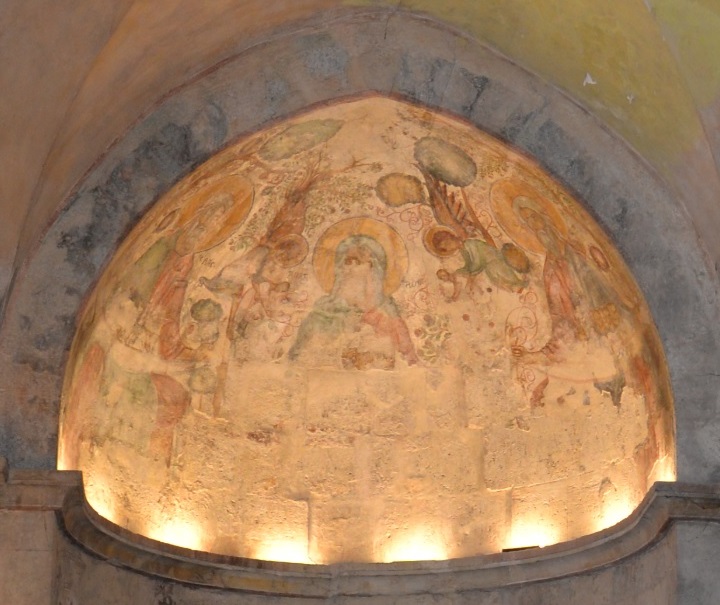
The PEF reported in 1875 on the frescoes ( Volume III, p. 134 ):
“The interior of the church is cemented, and was once painted in fresco on the cement. There are traces of the nimbi of saints on the apse-walls, and on the north walls various figures : a bishop In a pallium of Byzantine appearance, and architectural and geometrical designs are dimly visible. There are numerous graffiti on the walls, scratched on the paintings. The place was used at one time as a stable, but has been lately cleared out by the French Consulate.”.
The eastern side of the Crusader church was built over the Roman cistern, which provided water for the garrison. The western side of the Church was built over bedrock.
A staircase on the western side of the church leads down to the crypt, where the original area of the pool is located. Its size is 16.25m by 20.70m – the size of the Roman pool.
Next photo: A view of the staircase, looking up from the crypt.
In the center of the floor is a rectangular tank, which receives the water from the spring. The spring is located under the edge of the staircase.
The large slab behind the rope was the base of the altar which was erected over the spring.
A closer view of the rectangular rock-cut tank. The spring water enters from the western side, and drains thru a channel out to the eastern walls.
The south east vault has a narrow window, letting in some light.
Both north and south walls of the crypt were those of the Roman pool, though masked by pilasters supporting the vault.
The next photo shows the south eastern vault, also with a narrow window in the wall.
(f) Archeological Garden
The garden of the monastery has a number of interesting archaeological artifacts that were collected in the area.
On the lintel is an engraved double cross that was partially erased by the Muslims.
To the left of the entrance is a slab embedded into the wall, with an inscription. The Latin lines are:
“VEXILLAT(i)O LEG(ionis) X FRE(Tensis)”.
It mentions a vexillatio (a detachment of a Roman legion, formed as a temporary task force) of the 10th Legion (“LEG”) Ferentesis (“FRT”). This Legion was deployed in 66AD to quell the Great Revolt. The legion had a station house and guard post in Abu Ghosh until the end of the 3rd century AD.
Another similar inscribed slab is located inside the nearby Church of the Ark on Tel Kiriath Jearim.
A stone coffin is located nearby.
Another artifact is laid over a section of a column:
An oil press rolling stone and a milestone is located near the eastern entrance.
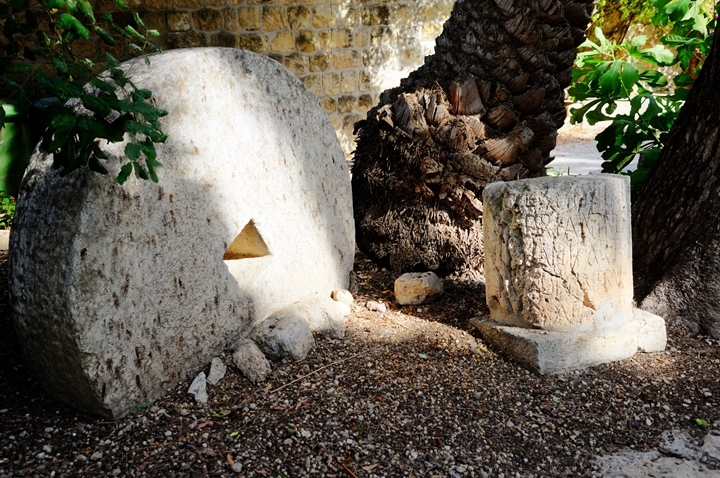
The Roman milestone is dated 162 AD. It bears the name of Caesar Marcus Aerelius, indicating the distance to Jerusalem.
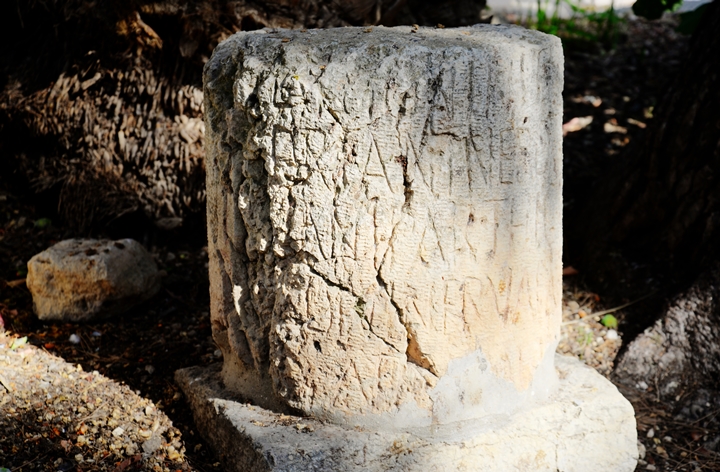
The following photo shows a view of the northern buildings of the monastery.
Names of the site:
- Kuryet al Enab – Arabic name the place, meaning: “Town of grapes”.
- el Kuryeh – another Arabic name, based on its identification with Kiryath of Benjamin ( Joshua 18:28 ).
- Kiriath Jearim (Kir’yat Ye’arim) – nearby Biblical site, mentioned as a station along the route of the Ark of Covenant’s return from the Philistines. Hebrew meaning: “Village of woods”.
- Abu Ghosh – modern Arabic name of the village around the site, based on the native family who lived here from the 16th century.
- Benedictine – St. Benedict was the father of Western monasticism (5th century in Italy), who wrote rules for monasticism life in the community (prayer, work and study). See also: Byzantine monks
Biblical References
After the resurrection, on the road to Emmaus ( Luke 24: 13-35 ):
“And, behold, two of them went that same day to a village called Emmaus , which was from Jerusalem about threescore furlongs. And they talked together of all these things which had happened. And it came to pass, that, while they communed together and reasoned, Jesus himself drew near, and went with them. But their eyes were holden that they should not know him. And he said unto them, What manner of communications are these that ye have one to another, as ye walk, and are sad? And the one of them, whose name was Cleopas, answering said unto him, Art thou only a stranger in Jerusalem, and hast not known the things which are come to pass there in these days?
Walk to Emmaus – Drawing by Gustav Dore (French artist, 1832-1883)
And he said unto them, What things? And they said unto him, Concerning Jesus of Nazareth, which was a prophet mighty in deed and word before God and all the people: And how the chief priests and our rulers delivered him to be condemned to death, and have crucified him. But we trusted that it had been he which should have redeemed Israel: and beside all this, to day is the third day since these things were done. Yea, and certain women also of our company made us astonished, which were early at the sepulchre; And when they found not his body, they came, saying, that they had also seen a vision of angels, which said that he was alive. And certain of them which were with us went to the sepulchre, and found it even so as the women had said: but him they saw not. Then he said unto them, O fools, and slow of heart to believe all that the prophets have spoken: Ought not Christ to have suffered these things, and to enter into his glory? And beginning at Moses and all the prophets, he expounded unto them in all the scriptures the things concerning himself. And they drew nigh unto the village, whither they went: and he made as though he would have gone further. But they constrained him, saying, Abide with us: for it is toward evening, and the day is far spent. And he went in to tarry with them. And it came to pass, as he sat at meat with them, he took bread, and blessed it, and brake, and gave to them. And their eyes were opened, and they knew him; and he vanished out of their sight. And they said one to another, Did not our heart burn within us, while he talked with us by the way, and while he opened to us the scriptures? And they rose up the same hour, and returned to Jerusalem, and found the eleven gathered together, and them that were with them, Saying, The Lord is risen indeed, and hath appeared to Simon. And they told what things were done in the way, and how he was known of them in breaking of bread”.
* Archaeology:
- Churches of the Crusader Kingdom of Jerusalem – Abu Ghosh – D. Pringle 1993
Abu Ghosh (North), Survey – Hadashot Arkheologiyot, Volume 124 (2012)
- Abbey web site
* Nearby sites :
- Kiriath Jearim – Tel and Church of the Ark of Covenant
- Nahal Ilan – a section of the Roman road that passed thru Abu Ghosh
- Castel – hilltop stronghold
- Tel Tzova – Roman village, Crusader castle
* Other BibleWalks pages:
- Drone Aerial views – collection of Biblical sites from the air
- BibleWalks Youtube channel
BibleWalks.com – travel with the Bible in hand
Horvat Midras <<<— previous site –<<< All Sites >>>— >>> —next Judea site—>>> Kiriath Jearim
This page was last updated on Dec 11, 2020 (added aerial views)
Ein karem and Abu Ghosh
Tour highlight.

St. John Church
Visit the traditional birthplace of John the Baptist and take a look at the archeological excavation below the church.

Visitation church
Visit the special visitation church, commemorating Mary's encounter with Elizabeth, John the Baptist's mother.

Visit the famous Arab village
Ein Karem and Abu Ghosh
Embark on a captivating journey as we venture into the heart of Israel's enchanting landscapes, exploring the picturesque treasures of Ein Kerem and the cultural delights of Abu Ghosh. The charming village of Ein Kerem welcomes us with open arms as if inviting us to step into a storybook.
Immediately upon arrival, the special atmosphere of Ein Karem washes over you. Its lush greenery, the flamboyant bougainvillea spilling over the stone houses of its resident artists, its burbling springs, and its historical churches and monasteries all combine to create a unique beauty.
On this tour, we will wander around this gentle town, meander between the natural springs. One, in particular, is known as Mary’s Well, the site where it is believed that Mary is believed to have sat and refreshed herself while on a visit to Elizabeth, mother of John the Baptist. Afterward, we will visit the Church of the Visitation, where the echoes of Mary's footsteps seem to whisper tales of old. Our tour will continue to the St. John Church, an old church, commemorating the birth of John.
In the afternoon we will make our way to the lively village of Abu Ghosh, a culinary haven that will treat your taste buds to an unforgettable feast. Renowned for its delectable Middle Eastern cuisine, Abu Ghosh invites us to indulge in authentic flavors that have stood the test of time.
After lunch, we will embark on an afternoon filled with cultural exploration. We will visit the stunning Abu Ghosh Monastery built by the Crausereds. Explore the intricacies of the monastery's architecture and learn about its captivating history.
More options on this tour: Nabi Samuel, Emmaus, Latrun
Abu Ghosh Kadyrob Mosque
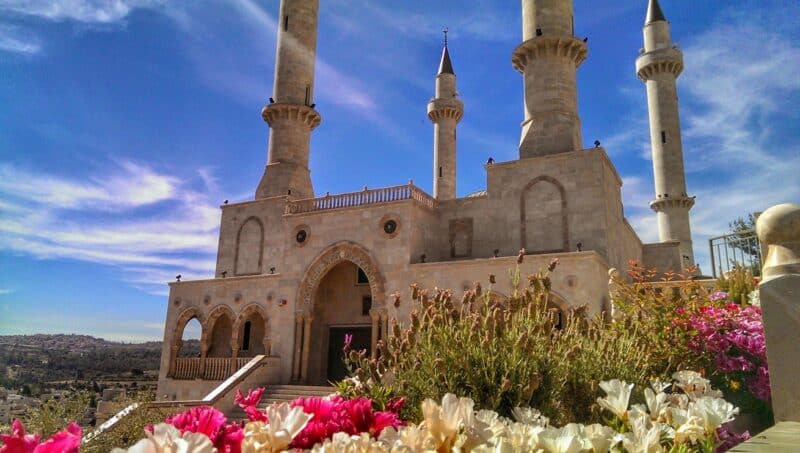
The Ahmad Kadyrov grand mosque in Abu-Ghosh is the second biggest mosque In Israel. Completed in 2014, it is named after Ahmad Haji Kadyrov, the Chechnian president who was assassinated in 2004.
History of the Kadyrov Mosque
The area of Abu Ghosh was settled already in the Neolithic age, some 6000 years ago. The Ark of the Covenant was stationed for 20 years at its hilltop (Kiryat Ya’arim), and later, it was a road station on the way to Jerusalem. The Crusaders erected a large church that is still intact to this day. In the Ottoman period, the site was known for being controlled by the Abu Gosh family, who imposed tolls on pilgrims passing through, as it was the main road to Jerusalem. Some recorded brutal attacks in demand of the tolls, locking, at times, the travelers until they paid. On the contrary, in the Israeli-Arab war in 1948, the village did not participate in any battles and even supported the Israeli forces.
The town claims to be of Chechnian descent. After the assassination of the Chechen leader, Ahmad Kadyrov, it offered his son and successor, President Ramzan Kadyrov, to jointly erect a mosque in Abu-Ghosh, in his father’s memory. Completed and opened in 2014, the mosque can hold up to 3000 people. It is designed in the Ottoman style, which is the favored architectural style in Chechnya. Its four minarets cannot be missed, and its marble coat gives it a unique and grand look.
Touring Abu-Ghosh Kadyrov Mosque
The Mosque is in the eastern side of the village. It is open to non-Muslims only on special request.
A tour of the Mosque can be combined with a guided day tour of Jerusalem .
Contact us to inquire more about a private tour of Jerusalem:
Keep exploring.

Saint Peter’s Church in Tiberias
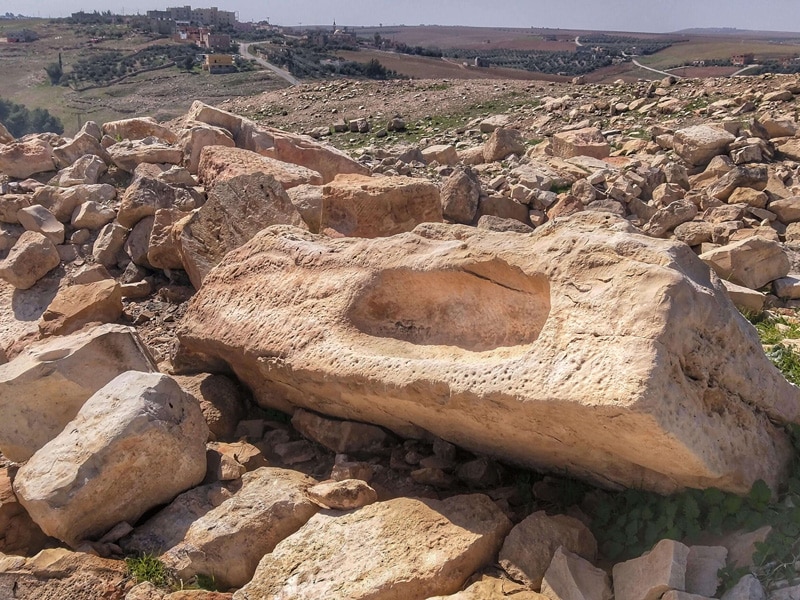
Dibon / Tel Dhiban

Khirbet Beit Loya – Home of Prophet Lehi?

‘Izbet Sartah and the Battle of Even Ha’ezer

Khirbet Qeiyafa
Related tours.

Best Private Tour of Jerusalem!
To the Holiest City In the World
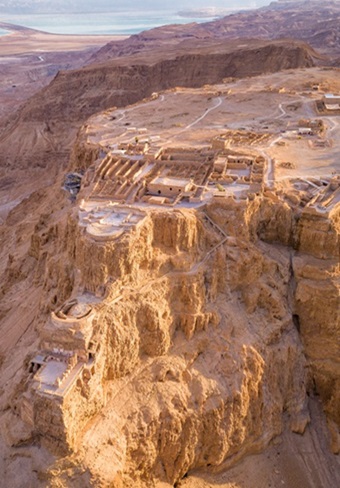
Private Tour to Masada and the Dead Sea
Exploring Desert Splendors

Jaffa and Tel-Aviv Private Tour
A Captivating Tour of Sites and Flavors
Related Posts

Lod Mosaic Opened to the Public
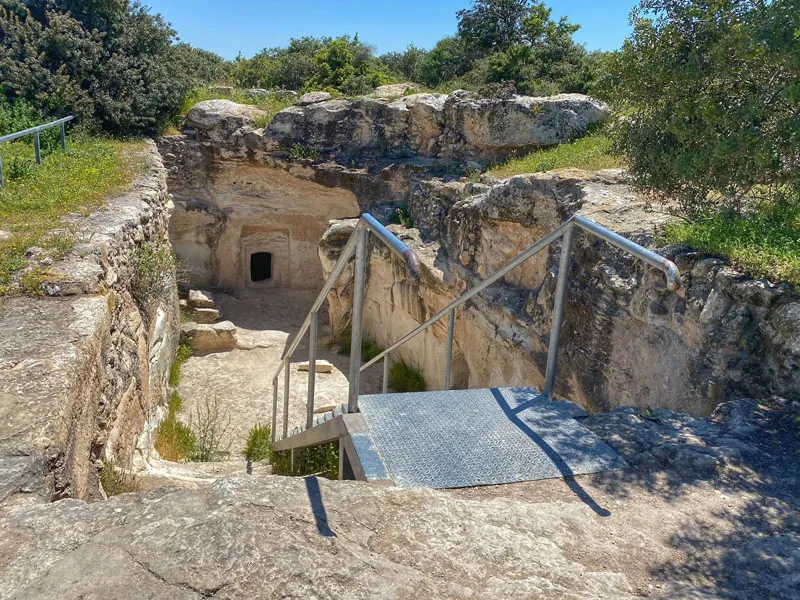
Horvat Burgin

Motza Temple Site
Contact us , and let’s start building your amazing getaway to Israel

Insert/edit link
Enter the destination URL
Or link to existing content
Expedia Rewards is now One Key™
Visit abu ghosh.
- Abu Ghosh Hotel Deals
- Vacation Rentals in Abu Ghosh

Reviewed on Jun 6, 2024

Reviewed on Feb 17, 2024

Reviewed on Jun 2, 2024

Reviewed on May 6, 2024

Reviewed on Mar 5, 2024

Reviewed on Oct 23, 2023
Check Abu Ghosh hotel availability
Popular places to visit.
- Al-Aqsa Mosque
Part of the sacred Temple Mount site, this lead-domed structure is a fully functioning mosque. It is among the holiest sites in the Islamic world.
- Western Wall
This 2,000-year-old structure is one of the world’s holiest sites, where hundreds of praying worshippers make for a stirring sight.
- Machane Yehuda Market
Get a taste of Jerusalem’s everyday life at this bustling market, home to little stores and stalls by day and restaurants and bars by night.
- Church of the Holy Sepulchre
This famous church stands at the site where, according to Christian belief, Jesus was killed, buried and later raised from the dead.
You can learn about the history of Jerusalem with a trip to Jaffa Gate. Make time for the shops and local tours in this culturally rich area.
- Israel Museum
Browse the exhibits at this large museum, which hosts valuable art collections as well as precious historical artifacts, including the Dead Sea Scrolls.
Things to do
Travel from jerusalem to bethlehem and dead sea - daily group west bank tour, travel to bethlehem half day guided tour from jerusalem & telaviv, travel to bethlehem, jericho & jordan river - group guided tour from jerusalem, full-day bethlehem, jericho, and jordan river tour, dead sea relaxation day tour from jerusalem, judean hills heart pumping atv action from jerusalem.
- Cities near Abu Ghosh

Mateh Yehuda
- Places of interest
- Benedictine Monastery in Abu Ghosh
- Ben Yehuda Street
- Mamilla Mall
- Mount of Olives
- Dome of the Rock
- Damascus Gate
- City of David
- Tower of David Museum of the History of Jerusalem
- Temple Mount
- Holyland Model of Jerusalem
- Garden Tomb
- Jerusalem Great Synagogue
- Notre Dame of Jerusalem Center
- King David's Tomb
- Via Dolorosa
- International Convention Centre
- Weizmann Institute of Science
- Jerusalem International YMCA
- Zion Square
- Hadassah Medical Center
- Hebrew University of Jerusalem Mount Scopus
- Hebrew University of Jerusalem
- Biblical Zoo
- Golden Gate

IMAGES
VIDEO
COMMENTS
Visit Abu Ghosh for scenic views, ancient churches, the New Mosque and great local cuisine. Nestled in the Judean hills just minutes from Jerusalem, Abu Ghosh is a small Arabic town that is well worth visiting. Most Israelis stop by Abu Ghosh mainly for its delicious Middle Eastern cuisine.
Things to Do in Abu Ghosh. 1. Saxum Visitor Center. 2. St. Mary of the Resurrection Abbey. The frescoes inside are truly awe-inspiring, even without faces and well worth a day trip out from Jerusalem or Tel... 3. Benedictine monastery in Abu Ghosh.
The town of Abu Gosh, just outside Jerusalem in the Jerusalem Hills is the unrivaled hummus capital of Israel, and some would say, the world. An Arab-Israeli village, Abu Gosh is famed across Israel for its fifteen amazing hummus restaurants, with Israelis traveling from far and wide to eat. As well as its food, Abu Gosh is famous for the Abu Gosh Music Festival, a vocal music festival which ...
Abu Ghosh Tourism: Tripadvisor has 1,363 reviews of Abu Ghosh Hotels, Attractions, and Restaurants making it your best Abu Ghosh resource.
Abu Ghosh (Arabic: أبو غوش; Hebrew: אבו גוש) is an Arab-Israeli local council in Israel, located 10 kilometers (6 mi) west of Jerusalem on the Tel Aviv-Jerusalem highway.It is situated 610-720 meters above sea level. It takes its current name from the dominant clan inhabiting the town, while the older Arabic name used to be Qaryat al-'Inab (Arabic: قرية العنب, lit.
Abu Ghosh is a picturesque village of 6,000. Just a few minutes drive of Jerusalem, is the Old Testament Kiryat Ye'arim and the New Testament Emmaus. its many tempting Middle Eastern restaurants, sweetshops, ceramic and glass shops and candle store make it the perfect place for a break or an overnight stay at one of its bed-and-breakfasts or at ...
1 Church of Our Lady of the Covenant, Abu Ghosh, ☏ +972 2-5342818. M-Sa 08:30-11:30, and 14:30-17:00. Located at the north-west part of the village of Abu Ghosh. The church is located at the summit of Tel Kiryat Ye'arim. The site is identified with the biblical Kiryat Ye'arim, where the Ark of Covenant was brought after it was captured ...
Benedictine Abbey of Abu Ghosh. The Benedictine Monastery in Abu Ghosh has been in the village for about 1,000 years, since the time of the Crusades, and includes the Church of the Resurrection. According to Christian belief, Abu Ghosh stands in Emmaus, the place where Jesus revealed himself to his disciples after he was resurrected, and the ...
A day out in Abu Ghosh, Ein Karem and Ein Sataf, enclaves near central Jerusalem where Israelis go to sip cappuccinos, shop for art, hike and otherwise forget that they live in one of the holiest ...
Places to visit in Abu Ghosh. Top Things to Do in Abu Ghosh, Israel. Places to Visit in Abu Ghosh. Enter dates. Attractions. Filters. Sort. Map. Category types. Attractions. Traveller Resources. Types of Attractions. Sights & Landmarks. Spas & Wellness. Traveller rating. Good for. Good for a Rainy Day. Good for Kids.
The Israeli Arab Village of Abu Ghosh is situated about 10 km west of Jerusalem, just off the main road from Tel Aviv. During Israel's War of independence, out of all the Arab villages in the area, only the residents of Abu Ghosh remained neutral and, in many cases, helped by assisting in keeping the road to Jerusalem open so that essential supplies could be sent to the besieged Jewish ...
Abu Ghosh Tourism: Tripadvisor has 1,354 reviews of Abu Ghosh Hotels, Attractions, and Restaurants making it your best Abu Ghosh resource.
A Benedictine monastery in Abu Ghosh, adjacent to Tel Kir'yat Ye'arim, on the side of the strategic ancient road to Jerusalem. This 12th century church is one of the most beautiful and interesting Crusaders structures in the Holy Land. It was built on the ruins of a Roman period water reservoir, and an Abbasid caravansarai.
Saxum Visitor Center. 74 reviews. #1 of 4 things to do in Abu Ghosh. Visitor Centers. Open now. 9:00 AM - 5:00 PM. Write a review. About. The Saxum Visitor Center helps pilgrims to deepen their knowledge of the Holy Land through different multimedia resources in order to enrich each person's Holy Land experience.
If you visit this village dotted with mosques, churches and craft shops, you will not lack for great places to eat. One of the well-known mosques in Abu Ghosh. Photo by Hadas Parush/Flash90. Read on for our recommendations. The Lebanese Restaurant. 88 Hashalom Road. The famous hummus from the Lebanese Restaurant in Abu Ghosh. Photo by Naama Barak
Mar 24, 2008. On the way up from Tel Aviv to Jerusalem, among turns and bends of the hilly scenery, lies the village of Abu Ghosh. It is a Christian-Arab village built on a mountainside. Looking up from its lowest point, you will see a charming and picturesque village. The village of Abu Ghosh was first settled over 6,000 years ago.
We will visit the stunning Abu Ghosh Monastery built by the Crausereds. Explore the intricacies of the monastery's architecture and learn about its captivating history. More options on this tour: Nabi Samuel, Emmaus, Latrun. More Tours. Tour description of Ein Karem- the birthplace of John the Baptist and a charming village outside of Jerusalem.
Visit Abu Gosh, an Arab-Israel town and great example of coexistence Head to one of the many hummus restaurants in Abu Gosh and taste some of the best hummus in Israel, as well as great salads and sweets, and, of course, sheesha (Arabic water pipe)
Blend.ar participants visit the 600-year-old cemetery during a tour of Abu Ghosh, October 2021. (Shmuel Bar-Am) I arrived in Abu Ghosh on the second day of the four-day program and began by ...
After the assassination of the Chechen leader, Ahmad Kadyrov, it offered his son and successor, President Ramzan Kadyrov, to jointly erect a mosque in Abu-Ghosh, in his father's memory. Completed and opened in 2014, the mosque can hold up to 3000 people. It is designed in the Ottoman style, which is the favored architectural style in Chechnya.
Visit Abu Ghosh. Things to do. Abu Ghosh Hotel Deals; Vacation Rentals in Abu Ghosh; Orient by Isrotel exclusive. 5 out of 5. 3 Emek Refaim St, Jerusalem. The price is $281 per night from Jun 23 to Jun 24. $281. $281 total. includes taxes & fees. Jun 23 - Jun 24. Stay at this 5-star luxury hotel in Jerusalem. Enjoy free WiFi, an outdoor pool ...
Travel Navigator. Find out where and when to go. Currency Calculator. Quickly and easily calculate foreign exchange rates. Country Comparison. ... Abu Ghosh is an Arab-Israeli local council in Israel, located 10 kilometers west of Jerusalem on the Tel Aviv-Jerusalem highway. It is situated 610-720 meters above sea level.
In the Arab Village of Abu Ghosh, an Expansion Dream Sours. Residents of the Arab village near Jerusalem waited years for a new neighborhood to be built. Now they can't afford to buy a home there — and fear that those who can will destroy the unique character of their community. The village of Abu Ghosh near Jerusalem, 2023. Credit: Emil ...